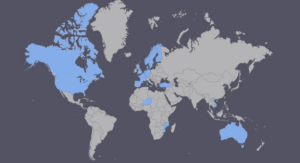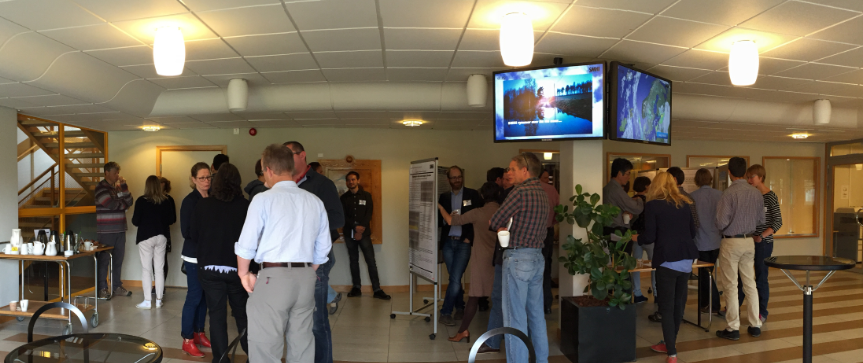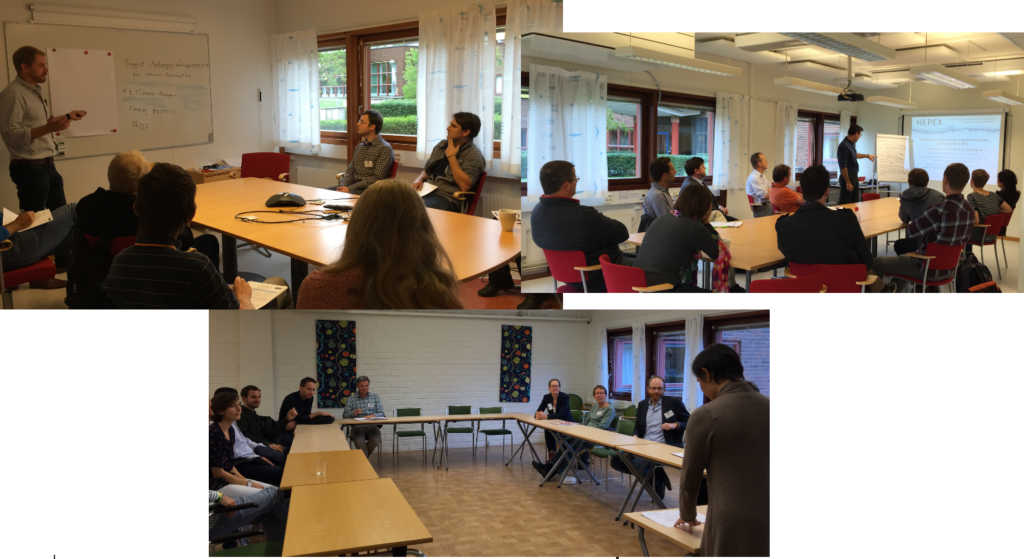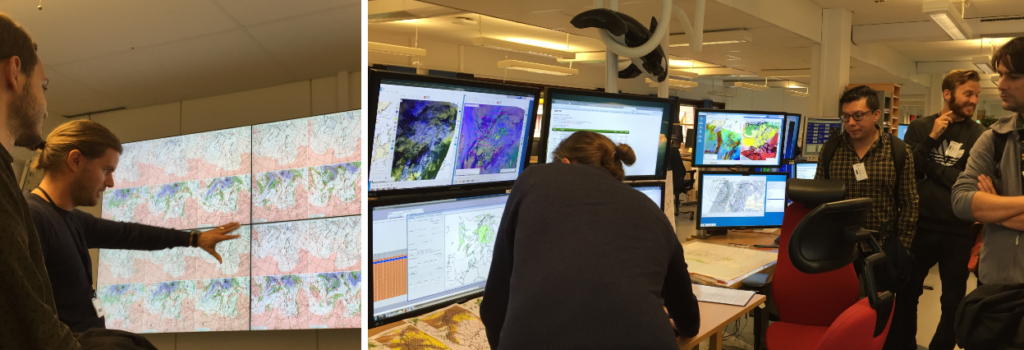Outcomes of the HEPEX workshop on seasonal hydrological forecasting at SMHI
Contributed by Maria-Helena Ramos, Fredrik Wetterhall, Andy Wood and Ilias Pechlivanidis
Registrations indicated 17 different countries
All in all, 55 participants attended last week’s HEPEX workshop on seasonal hydrological forecasting at SMHI. The aim of the workshop was to provide a forum for users, forecasters and researchers to discuss common issues and exchange ideas and experiences. The participation from all over the world, with a total of 30 oral and poster presentations bears witness of the interest in the topic.
The workshop was organised around six themes:
- User needs, communication and decision making
- Climate and water services using seasonal forecasts
- Towards operational monthly to seasonal forecasting systems
- Improving skill of seasonal forecasts
- Quality and predictability of seasonal predictions
- Sub-seasonal to seasonal predictions and applications in hydrology
Poster session at the workshop
Presentations are available to download here.
During the workshop we had plenty of time for discussions and we even tested a new formula to activate discussions already on the first day of work: the speed dating with three ‘challenge holders’ (the leaders of the breakout sessions)! The participants were divided into three groups which were given 15 minutes to discuss a challenge with a challenge holder and then rotated. The topics are listed below:
- Challenge Holder 1: Uncertainty and predictability
How much uncertainty can users tolerate? How much can uncertainty can we quantify with our current systems (strengths/weaknesses)? How well do our systems harness sources of predictability (initial hydrologic conditions, future climate?) - Challenge Holder 2: Challenges and Opportunities
What are the biggest challenges & opportunities for seasonal hydrological forecasting?
eg, does climate change pose a challenge for seasonal forecasting methods? What factors limit the production and use of seasonal forecasts? Are there sources of skill or outreach we do not leverage? - Challenge Holder 3: Modelling and users’ needs
What models or systems do we have to offer? What products are possible? eg, volume distributions, tendencies for extremes? Who looks at what (eg by sector)?
Speed-dating with Challenge Holders
Although the topic of Challenge Holder 1 had a net preference from participants, all three challenges were intensively discussed during each 15-min speed date. The full summary of the discussion can be found here. Some main take-away messages are:
- Understanding of uncertainty varies between end-users and modellers, depending on experience and education.
- Despite the ability to represent uncertainty, efforts are needed to improve communication between modellers and end-users.
- Tolerance of uncertainty depends on the end-user (e.g., some users are happy to only take guidance) and the lead time, which again leads back to the lead time that the end-users are most interested in.
- Modellers/forecasters should not focus solely on generating results but must also take into account the impact of their results on decisions.
- We need to understand better the limitations of climate forecasts and how to make the best use of them: i.e. when and where are they the best source of predictability?
- Our holy grail: integrated end-to-impact forecast!
- Products should be associated with verification metrics (which are easily understood and disseminated).
- Users and users’ needs are diverse, and interpreted information linked to impact may be of great value to users.
- Hydrological forecasts are only one part of the decision making!
Challenges and opportunities were raised:
- Communication is still a challenge: need to increase transparency in methods and decisions to the user.
- Technical improvements are still necessary: increasing reliability in dynamical seasonal forecasts through statistical calibration techniques.
- There is an opportunity today for increasing knowledge with more case-studies, scientific articles, and a growing community on seasonal forecasting for hydrology and water management.
- Examples of impact-base forecasts can be of great benefit to a better understanding of forecast skill (and limits) and usefulness (added-value).
- Improving forecast skill also includes issuing reliable forecasts on new time horizons.
Participants listening attentively to Micha Werner’s presentation
A tour of SMHI
Henrik Spångmyr (SMHI) kindly played twice the role of our guide, letting us know more about SMHI models and tools in hydrometeorological forecasting. The forecast room impressed us all – not only because we are forecast aficionados – but also for its richness of means to analyze real-time data, deterministic and ensemble forecasts from a variety of data sensors and numerical models. A nice experience and a big thank you to Henrik!
Visiting SMHI
And what’s next?
At the workshop, we also discussed about creating a task force on seasonal hydrological forecasting and implementing it through an seasonal forecast inter-comparison experiment or ‘testbed’.
The goal of the experiment is to take a pragmatic look at the range of forecast methods, data and opportunities that exist now for seasonal hydrologic prediction, and to investigate, under a common protocol, the strengths and weaknesses of differnet approaches, given different types of users, hydroclimates and needs.
The proposed testbed would start simply, with:
- a core team: some volunteers already expressed their interest and we will soon communicate about it through the HEPEX Portal. If you are also interested, please leave a comment here or contact Andy Wood (NCAR,USA) or Andrew Schepen (CSIRO, Australia);
- a focus initially on 6-8 catchments, geographically distributed, where regulation effects are negligible, good data or models are available, and seasonal forecasts have an impact on user decisions;
- defining a common protocol with guidelines on the forecasts (hindcasts) to be generated for the intercomparison, shared data formats, and the metrics to be used in verification. The protocol will allow transparency and repeatability of results;
- developing a wiki page where basic information could be easily found and through which knowledge building and sharing could be promoted to increase the participation of interested people.
Finally, we would like to thank all participants and specially our keynote speakers and chairpersons, who much contributed to the success of the workshop: QJ Wang, Christel Prudhomme, Erik Tjøtta, Micha Werner, Massimiliano Zappa, and Christopher White.
Participants at the HEPEX workshop on seasonal hydrological forecasting at SMHI, 21-23 September 2015 – See also the Photo Gallery for more HEPEX photos.






October 2, 2015 at 22:18
Hi,
Thanks for posting the major discussions in the meeting. I had been following #hepex on twitter to stay updated with the different presentations. There were some really nice presentations.
I am currently working on building a real time flood forecasting system for an Indian catchment, in collaboration with Potsdam Institute for Climate Impact Research. We have good quality data, both ground based and weather forecasts (ECMWF), and we are using a number of different hydrologic models (VIC, SWAT, etc.) for issuing flood warnings at different lead times. I want to get more involved in hepex (in the core team).
October 4, 2015 at 17:21
Great to hear you enjoyed following the workshop. Thanks for the message and let’s get in touch for further contributions to HEPEX!